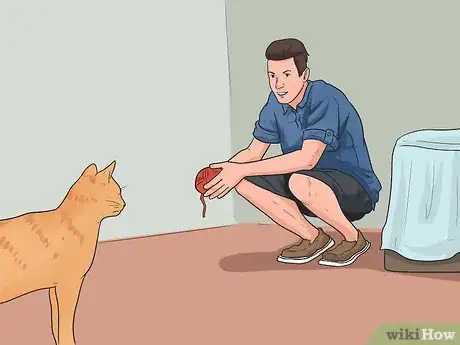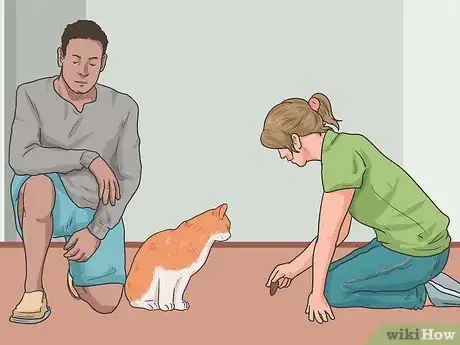wikiHow is a “wiki,” similar to Wikipedia, which means that many of our articles are co-written by multiple authors. To create this article, 64 people, some anonymous, worked to edit and improve it over time.
This article has been viewed 291,585 times.
Learn more...
Contrary to popular belief, it actually is possible to train a cat! One way to train your cat is to teach her to come when you call her. Fortunately, cats typically learn this skill pretty easily, so it shouldn't take too long before your cat consistently responds to your call. With a little bit of patience and a lot of rewards, you should eventually be able to call your cat from anywhere in the house and have her come running (or walking) to you.
Steps
Preparing to Call Your Cat
-
1Learn the benefits of calling your cat. There are several benefits to having your cat come to you when you call her. For example, you can call her when it's playtime or mealtime.[1] You can also call your cat if you are unable to locate her in your home. In addition, when your cat knows how to come to you when you call her, you will have the reassurance that she is safely accounted for if you have to leave the house.
- If your cat is indoor/outdoor, it will be helpful to call her to come back inside.[2]
- Calling your cat is also beneficial when it is time to leave the house for her veterinary appointment.[3] Your cat may not view a trip to the veterinarian as a pleasant experience, so you may need to allow some extra time to get her come to you when it's time to leave for her appointment.
- Because cats are naturally intelligent, teaching your cat to come to you when she is called is a great mental exercise for her.[4]
-
2Select a reward. Although positive reinforcement (verbal praise, petting) is an important component of successful training, the key to training your cat to respond to your call is an enticing reward.[5] The most enticing reward for her will probably be food that she thinks is delicious, such as tuna, shredded chicken, or sardines.[6] You can also purchase cat treats at your local pet store.
- Keep multiple treats on hand. When you reward her, you can vary which food you reward her with so that she does not come to expect the same reward each time.[7]
- Catnip is not a good reward. Your cat's desire for catnip would likely diminish if she receives it more than once a week, so it would be best to select a food treat that will consistently entice her.
- Whichever food reward you choose, use it only when you call her. It is preferable for your cat to associate that tasty reward with responding to your call and no other commands or verbal cues.[8]
- Playtime can also be an enticing reward.[9]
Advertisement -
3Decide what verbal cue you will use to call your cat. You can use any verbal cue that you would like.[10] One common verbal cue that cat owners will use is “Here, kitty kitty.” You can also use the words “come” or “treats.” The verbal cue should not be something that you already use, such as her name.[11]
- You can also use various tones of voice. Cats typically respond to a high-pitched tone of voice, since their prey usually makes high-pitched sounds in the wild.
- If you are not the only person in the house who would be calling your cat, make sure that everyone uses the same verbal cue and tone to call her.
- If your cat is deaf or hard of hearing, you will need to use some different methods to get her attention, such as visual cues– flicking a light on and off or using a laser pointer (available at your local pet store). Deaf or hearing-impaired cats also respond to vibrations in the floor, so you can thump or stomp of the floor to call your cat.[12] [13]
Calling Your Cat
-
1Choose when you are going to call your cat. A convenient time to practice calling your cat is around feeding time. Your cat will likely already be hungry, which may make the training process easier and faster.[14] In addition, she will already be used to going to the kitchen (or wherever you keep her food bowl), so you will not be calling her to a room that is unfamiliar to her when you begin training her.
- Another benefit to calling her at her regular feeding time is that she will already know what time to get her food. This will make the initial training easier because you will not be doing something that is completely unfamiliar to her.
- If you choose to reward with her extra play, then you can practice calling her when it's getting close to her scheduled playtime.[15]
- If the kitchen and her play areas have a lot of distractions, consider calling your cat in a quiet room that doesn't have any distractions that could keep her from coming to you.[16]
-
2Call your cat. When you are in the room where you want her to come to you, say your verbal cue in a high-pitched voice. If you are calling her when it's time for her to eat, make sure that you say the verbal cue before you open a can of food or rip open a bag of food. You want to ensure that your cat comes because she heard your verbal cue, not because of the noises of food preparation.[17]
- Reward her immediately when she comes to you, whether that is with the tasty treat or extra playtime.[18] Extra positive reinforcement through petting and verbal praise will also be helpful.
- Even if you are calling her at mealtime, it is still important to give her the tasty treat as a reward, rather than just feeding her the regular food.
- If you are calling her around playtime, say the verbal cue without shaking a toy that makes noise.
- It may take her a week or so before she starts to consistently come to you when you call her.[19]
-
3Increase the challenge of calling your cat. Once your cat consistently comes to her play or feeding areas when you call her, take the difficulty up a notch. For example, if someone else lives with you, you can practice calling her back and forth between you and other person. For this challenge, each person should reward her when she correctly responds to the call.[20]
- If your cat is indoor/outdoor, you can also practice calling her back inside when she is outside.[21] This would be more practical when she is a relatively close distance to the house where she could hear you.
- Practice calling her from each of the rooms in your house. Eventually, she will learn how to come to you from wherever she is in your house.[22]
Expert Q&A
-
QuestionHow do I call my cat at night?
 Pippa Elliott, MRCVSDr. Elliott, BVMS, MRCVS is a veterinarian with over 30 years of experience in veterinary surgery and companion animal practice. She graduated from the University of Glasgow in 1987 with a degree in veterinary medicine and surgery. She has worked at the same animal clinic in her hometown for over 20 years.
Pippa Elliott, MRCVSDr. Elliott, BVMS, MRCVS is a veterinarian with over 30 years of experience in veterinary surgery and companion animal practice. She graduated from the University of Glasgow in 1987 with a degree in veterinary medicine and surgery. She has worked at the same animal clinic in her hometown for over 20 years.
Veterinarian If a cat slips outside on a dark night, they instinctively go to ground. The cat may be too frightened to leave cover and therefore be difficult to find. But if they are trained to their name, the cat should have the confidence to break cover and come out of hiding.
If a cat slips outside on a dark night, they instinctively go to ground. The cat may be too frightened to leave cover and therefore be difficult to find. But if they are trained to their name, the cat should have the confidence to break cover and come out of hiding.
References
- ↑ https://www.aspca.org/pet-care/virtual-pet-behaviorist/cat-behavior/teaching-your-cat-come-when-called
- ↑ https://www.aspca.org/pet-care/virtual-pet-behaviorist/cat-behavior/teaching-your-cat-come-when-called
- ↑ http://www.vetstreet.com/our-pet-experts/training-your-cat-to-come-when-called?page=2
- ↑ https://www.aspca.org/pet-care/virtual-pet-behaviorist/cat-behavior/teaching-your-cat-come-when-called
- ↑ https://www.aspca.org/pet-care/virtual-pet-behaviorist/cat-behavior/teaching-your-cat-come-when-called
- ↑ http://www.vetstreet.com/our-pet-experts/training-your-cat-to-come-when-called?page=2
- ↑ https://www.aspca.org/pet-care/virtual-pet-behaviorist/cat-behavior/teaching-your-cat-come-when-called
- ↑ http://www.vetstreet.com/our-pet-experts/training-your-cat-to-come-when-called?page=2
- ↑ https://www.aspca.org/pet-care/virtual-pet-behaviorist/cat-behavior/teaching-your-cat-come-when-called
- ↑ https://www.aspca.org/pet-care/virtual-pet-behaviorist/cat-behavior/teaching-your-cat-come-when-called
- ↑ http://www.vetstreet.com/our-pet-experts/training-your-cat-to-come-when-called?page=2
- ↑ http://www.vcahospitals.com/main/pet-health-information/article/animal-health/living-with-a-deaf-cat/8095
- ↑ http://www.vetstreet.com/our-pet-experts/training-your-cat-to-come-when-called?page=2
- ↑ http://www.vetstreet.com/our-pet-experts/training-your-cat-to-come-when-called?page=2
- ↑ https://www.aspca.org/pet-care/virtual-pet-behaviorist/cat-behavior/teaching-your-cat-come-when-called
- ↑ https://www.aspca.org/pet-care/virtual-pet-behaviorist/cat-behavior/teaching-your-cat-come-when-called
- ↑ https://www.aspca.org/pet-care/virtual-pet-behaviorist/cat-behavior/teaching-your-cat-come-when-called
- ↑ https://www.aspca.org/pet-care/virtual-pet-behaviorist/cat-behavior/teaching-your-cat-come-when-called
- ↑ https://www.aspca.org/pet-care/virtual-pet-behaviorist/cat-behavior/teaching-your-cat-come-when-called
- ↑ https://www.aspca.org/pet-care/virtual-pet-behaviorist/cat-behavior/teaching-your-cat-come-when-called
- ↑ https://www.aspca.org/pet-care/virtual-pet-behaviorist/cat-behavior/teaching-your-cat-come-when-called
- ↑ https://www.aspca.org/pet-care/virtual-pet-behaviorist/cat-behavior/teaching-your-cat-come-when-called
- ↑ http://www.vetstreet.com/our-pet-experts/training-your-cat-to-come-when-called?page=2
- ↑ https://www.aspca.org/pet-care/virtual-pet-behaviorist/cat-behavior/teaching-your-cat-come-when-called
- ↑ http://www.vetstreet.com/our-pet-experts/training-your-cat-to-come-when-called
- ↑ https://www.aspca.org/pet-care/virtual-pet-behaviorist/cat-behavior/teaching-your-cat-come-when-called
- ↑ https://www.aspca.org/pet-care/virtual-pet-behaviorist/cat-behavior/teaching-your-cat-come-when-called
About This Article
To call a cat, call out a verbal cue such as “Here, kitty, kitty” in a high-pitched voice. In the beginning, try calling your cat during feeding times, since the cat is more likely to come to you when it’s hungry. Eventually, start calling the cat at different times of the day, and reward it with a treat or play time as soon as it comes. Once your cat starts coming to you consistently for play or feeding, try calling it from each room in your house so that your cat learns to come to you no matter where you are. For more advice from our Veterinary reviewer, including how to use vibrations and visual cues to call your cat, keep reading.

































































